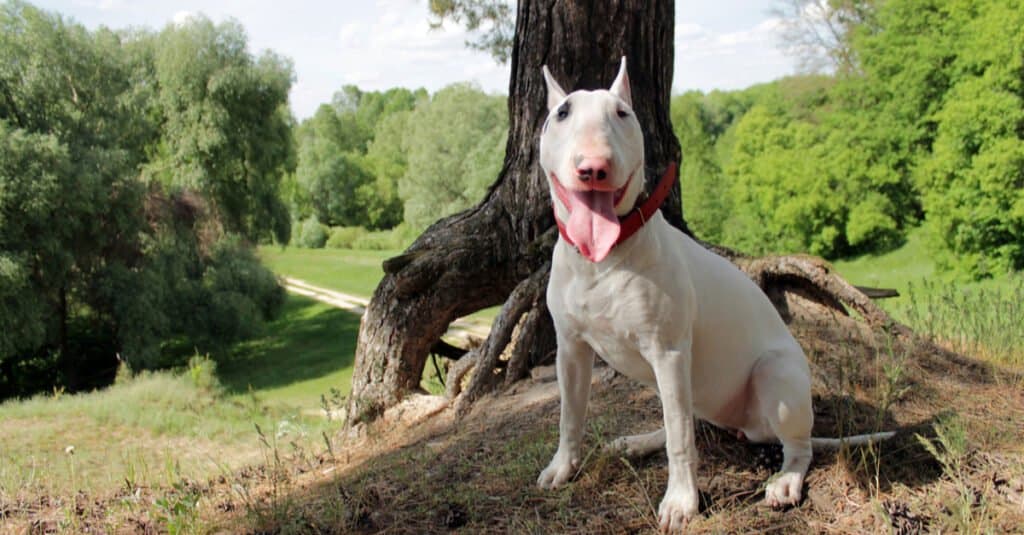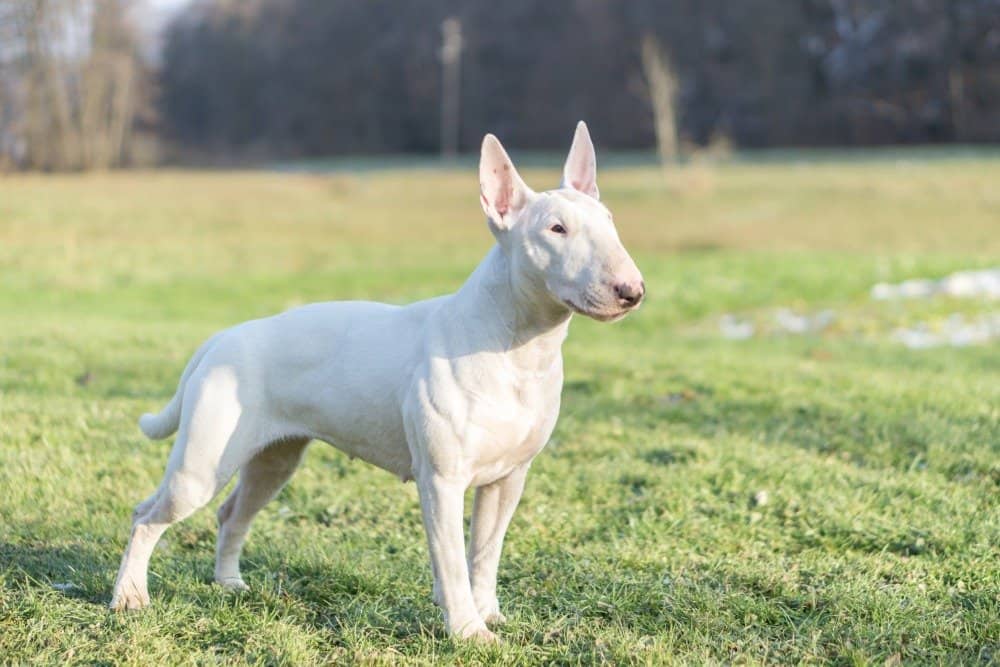Breaking down the male vs. female bull terrier comparison starts with what they have in common. For instance, the core bull terrier personality is there for both. Bull terriers are friendly, energetic, playful, and have unique and fun personalities.
They’re also highly affectionate dogs. They straddle the line between full-blown lapdog and the curl-up next to you on the couch dog. What they are mostly known for is their unique appearance, with many bull terrier owners affectionately referring to them as “eggheads”.
Bull terriers are bulky, muscular-looking dogs, but not necessarily large. With all of these things in common, separating a male vs. female bull terrier is an exercise in subtleties. The differences are there, but there isn’t a vast gulf between the two.

Comparing a Male and Female Bull Terrier
| Male Bull Terrier | Female Bull Terrier | |
|---|---|---|
| Height | Up to 22″ | Up to 20″ |
| Weight | 55 lbs to 65 lbs | 45 lbs to 55 lbs |
| Health | Highly active but prone to prostate cancer if not neutered | Semi-active and prone to ovarian or mammary cancer if not spayed |
| Temperament | Playful, curious, adventurous, active, potentially aggressive | Active but more laid back and highly affectionate |
| Training | Highly trainable, especially if neutered | Easier to train and socialize earlier on, thanks to their chill temperament |
6 Key Differences Between a Male and a Female Bull Terrier
The key differences between a male vs. female bull terrier are subtle in some areas and a little more obvious in others. As you can see, by their height and weight, the differences are an inch or two and generally between 5 and 10 lbs. That means the key differences are more on the social and interactive side.
These differences include overall attitude, activity levels, aggression (or lack thereof), ease of training, and other personality attributes. We’ll cover the size and physical traits as well, even though you need a side-by-side view of the male and the female to tell the difference.
1. Male vs. Female Bull Terrier: Size

White bull terrier with a large, black eye patch.
©Eudyptula/Shutterstock.com
For the most part, the female bull terrier is smaller than the male, but not by much. A male bull terrier that reaches the peak of the breed’s size and weight will stand 22″ tall and weigh between 55 and 65 lbs. In general, this places the male in the large dog category. The female at peak healthy height and weight is roughly 45 to 55 lbs and 20” tall.
2. Male vs. Female Bull Terrier: Physical Traits

Female bull terriers are far more likely to spend time chilling on the couch with you than their male counterparts.
©Georgiy M/Shutterstock.com
If you look at both the female and the male from the side, there’s not much of a difference between the two. However, face them both head on and the male is noticeably broader in the shoulders, with a more square and aggressive-looking stance (though it’s not being aggressive). Both the female and the male are muscular, with a pointy shape and the tendency to lean forward, as if ready to charge.
3. Male vs. Female Bull Terrier: Reproduction

Close-up of a white English bull terrier.
©iStock.com/SergeyTikhomirov
The AKC highly recommends spaying or neutering your female or male bull terrier. This is mostly because they tend to develop cancer within their reproductive system. However, it’s also beneficial to the male because it tends to exhibit a higher degree of situational aggression without neutering.
Both male and female bull terriers reach sexual maturity quickly, with the males becoming mature at roughly 6 months and the females at 4 months. It’s a good idea to neuter your male before it reaches 8 months of age and spay your female after her first heat. Some recommend spaying before her first heat, however, the first time a female goes into heat is often unpredictable.
4. Male vs. Female Bull Terriers: Health Considerations

Brindle bull terrier with a large splash of white.
©otsphoto/Shutterstock.com
In terms of health considerations, male and female bull terriers are kind of the same in that they both tend to develop cancer in their reproductive organs. Of course, this is assuming that you don’t get them fixed when they’re young.
Bull terriers, whether male or female, require a balanced and sustained diet, especially throughout their formative years. It will take anywhere between 18 and 24 months for a bull terrier to reach its maximum size. By the end of year one, most of that growth is behind them. However, they will continue to get bigger and become less gangly for another 6 months to a year.
As active dogs, they will need plenty of outdoor access to run and play, along with several minutes a day set aside for training and playing. It’s important to engage their brains, which lessens the potential for aggression, anxiety, and other bad behaviors, such as chewing up anything in sight. A balanced diet that changes as the male or female bull terrier grows (according to their needs), is essential.
5. Male vs. Female Bull Terrier: Temperament

Bull terrier posing in front of a tree.
©Anna_Bondarenko/Shutterstock.com
As is usual in dogs, the male is more active and the one that’s more likely to engage in aggressive behavior. This is especially true if he’s not neutered while still young. Both females and males are highly affectionate, though the female is much more so than the male. If you’re looking for a dog that sticks to your side constantly and practically lies on your lap when you’re on the couch, the female is the obvious choice.
While the male is more prone to aggressive behavior, that’s not to say it’s an aggressive dog. Aggression is more of an issue when there are two male dogs in the room, neither are neutered, and neither is familiar with the other. Male bull terriers are wonderful with family members, highly affectionate, and very loyal.
6. Male vs. Female Bull Terrier: Training

White bull terrier showing off its unique appearance and stance.
©24K-Production/Shutterstock.com
Females are generally easier to train than their male counterparts. However, they also have an independence streak, which often presents itself as a lack of understanding. Female and male bull terriers are not low-intelligence dogs. The odds are good that she understands you, but she just doesn’t want to roll over, sit, or play dead.
The males are more difficult to train, but they’re one of the easier dogs to train if that makes sense. Their active and boisterous lifestyle tends to lead toward distraction. The best way to train a male is to start things off in a quiet room, away from all distractions. They train well, so long as you start small and work your way up from there.
Final Thoughts
Male vs. female bull terriers is kind of a personal lifestyle choice. Do want a highly affectionate, extremely active dog with high energy? Or, do you prefer an active but highly affectionate dog that’s more likely to spend an entire afternoon in your lap? Though both the male and female have a lot in common, the female is liable to be more of the “lounge around the house and snuggle” type of dog.
The male is the one you want to take with you on your morning jog. Both males and females have plenty of energy, but the male is often more willing to spend it.
The photo featured at the top of this post is © Valeri Vatel/Shutterstock.com
Thank you for reading! Have some feedback for us? Contact the AZ Animals editorial team.







